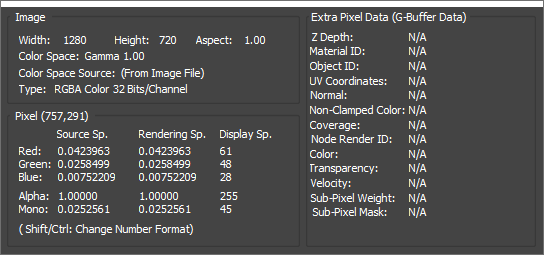When you right-click the Rendered Frame Window or View Image Windowthe color swatch is updated and information about the rendering and the pixel beneath the mouse is displayed.
If you hold the right mouse button down while dragging, the information changes with each new pixel the mouse crosses.

The display includes the following information:
Image group
- Width
- The width of the image in pixels.
- Height
- The height of the image in pixels.
- Aspect
- The pixel aspect ratio.
- Color Space
- The space of the underlying color values before any adjustments for display.
- In Gamma Workflow color-management mode, this is typically "Gamma 2.20" (for ordinary sRGB images) or "Gamma 1.00" (non-color data or rendered frames).
- In an OCIO color-management mode, this is the name of the rendering space (for rendered frames) or the input space (for image files).
- Color Space Source
- How the underlying color space was determined. In Gamma Workflow color-management mode, the possible values are:
- (From Image File): The gamma value was read from the value embedded in the file.
- (Inferred from File): There was no embedded gamma so the value was automatically inferred from the format: either the system gamma (typically 2.20) for 8-bit and 16-bit integer formats or 1.00 for floating-point formats.
- (From User Override): The gamma was manually specified.
- Rule name: The color space was automatically determined by the specified rule in the configuration file.
- System Heuristics: The system otherwise determined the space automatically. For example, rendered frames in memory are known to be in the rendering space even if there is no file name and extension that the rules can be applied to.
- User: The color space was declared manually on loading.
- Not Set. Under normal circumstances, this should not occur.
- Type
- The type of image, based on color depth.
For example, a full-color image with an alpha channel will show “RGBA Color 16 Bits/Channel”; a bitmap with a limited color depth might show “Indexed Color 8 Bits/Pixel,” and so on.
Pixel group
Pixel information includes the pixel location in the bitmap, in parentheses following the Pixel group heading. The counting starts at 0. For example, in the above illustration, the pixel in question is the 757th from the left edge and the 291st from the top edge. Also shown in this group are channel values for red, green, blue, alpha, and monochrome in the source and rendering spaces as floating-point values and in the display space as 8-bit integers. To change the value format, press Shift (for 8-bit integers) or Ctrl (for 16-bit integers) while holding the right mouse-button down to keep this window open — you may need to move the mouse to force the values to update.
- Red
- The red component value.
- Green
- The green component value.
- Blue
- The blue component value.
- Alpha
- The alpha component value.
- Mono
- The monochrome values of the pixel, using the same formula used by monochrome material map channels such as bump and opacity maps.
Extra Pixel Data (G-Buffer Data) group
If the rendering output uses a format that contains additional channels, such as RPF or RLA, the informational pop-up shows this data in the Extra Pixel Data group. The group includes all the possible channels. If a channel is not present, its value is displayed as "N/A," for "not applicable."
- Z Depth
- Displays Z-Buffer information in repeating gradients from white to black. The gradients indicate relative depth of the object in the scene.
- Material ID
- Displays the Effects Channel used by a material assigned to an objects in the scene. The Effects Channel is a material property set in the Material Editor.
- Object ID
- Displays the object’s G-Buffer Object ID.
- UV Coordinates
- Displays the range of UV mapping coordinates.
- Normal
- Displays the orientation of normal vectors.
- Non-Clamped Color
- Displays the "real" color value in RGB order. The renderer uses floating-point values to represent each color channel where 0.0 is pure black, 1.0 is white, and light sources and specular highlights can have values above 1.0 .
- Coverage
- Displays the coverage of the surface fragment from which other G-Buffer values (Z Depth, Normal, and so on) are obtained. Z-Coverage values range from 0 to 255.
- Node Render ID
- Displays an object’s G-Buffer Object channel.
- Color
- Displays the color returned by the material shader for the fragment.
- Transparency
- Displays transparency returned by the material shader for the fragment.
- Velocity
- Displays the velocity vector of the fragment relative to the screen.
- Sub-Pixel Weight
- Displays the sub-pixel weight of a fragment. The channel contains the fractions of the total pixel color contributed by the fragment. The sum of all the fragments gives the final pixel color. The weight for a given fragment takes into account the coverage of the fragment and the transparency of any fragments that are in front of a given fragment.
- Sub-Pixel Mask
- Displays the sub-pixel alpha mask. This channel provides a mask of 16 bits (4x4) per pixel, used in antialiased alpha compositing.
